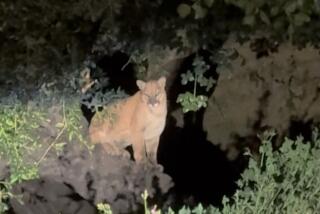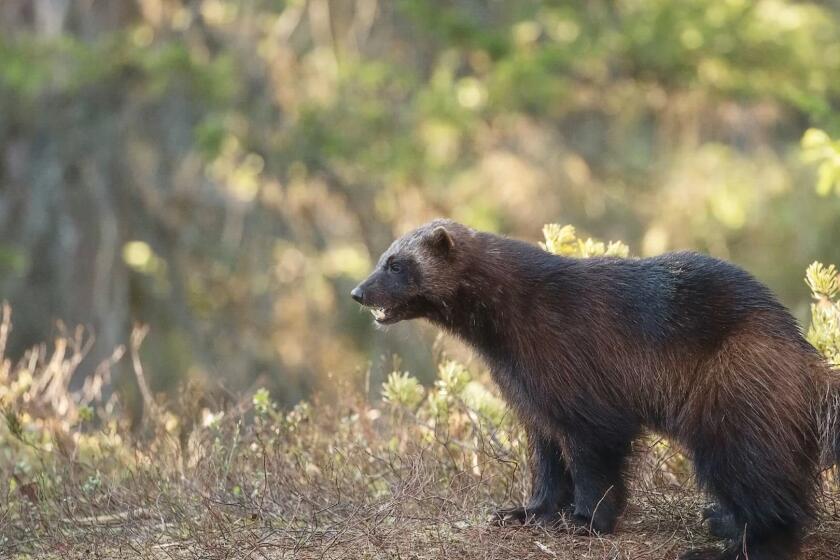Thresher Shark Packs Plying Deep Blue of Santa Monica Bay
It’s news that will make fishermen drool and swimmers gasp: The Santa Monica Bay has been invaded by sharks.
OK, so they’re only thresher sharks, which pose no threat to swimmers.
But the presence of these delectable acrobats in portions of the bay from El Segundo north has anglers excited for a couple of reasons. One is that these whippy-tailed game fish--the sharks are averaging 40 to 80 pounds--are extremely fast swimmers and leap often when hooked. The other is that their being here also might be an indication that the banning of gill-nets in coastal waters years ago is finally paying dividends.
Indeed, the scene Tuesday aboard the New Del Mar was out of the distant past, when threshers made regular forays into the bay.
“We just set up a chum line on a local structure and pretty soon we had these sharks coming up and boiling off the stern like yellowtail or seabass,” said Ricky Carbajal, the boat’s skipper. “There was a big pack of sharks and when one of them was hooked and brought up along the stern, there would be two or three others swimming behind it.
“One of the old-timers on the boat asked, ‘Does this always happen?’ I said, ‘No, it does not.’ ”
In all, 22 threshers were hooked and only five landed because none of the anglers had heavy enough line on their spools.
A woman Carbajal could remember only as Amber was the top stick, as they say, going three for three, with her largest shark weighing 75 pounds.
“There were some over 100 pounds that we just couldn’t stop,” Carbajal said, adding that the sharks are still around and seem to be congregated off El Segundo and the Temescal Canyon areas.
A private boater claimed to have caught eight thresher sharks Thursday, including a 200-pounder, off El Segundo.
BRIEFLY
* Niland: It’s 110 degrees and muggy down there, but that’s par for the course nowadays in the southeast corner of the state. And so are birdies at Lakeview Golf Course, a nine-hole par-33 layout alongside the Rio Bend RV Resort Ranch. Doves are everywhere, says Keith Earle, the club pro and an avid dove hunter looking forward to the season opener Sept. 1.
“Judging from the population on the course and in the trees I’d say this year ought to be just as good if not better than last year. Hunters in their traditional spots ought to have no trouble getting their [10-bird] limit,” Earle says. “Unless something crazy with the weather happens and shoos them all away. But we had a big thunderstorm two weeks ago and it didn’t affect the population at all.”
* Avalon: Larry Kennison of Balboa Island caught the first marlin of the season off Catalina last Saturday, landing the 123-pounder on 20-pound dacron line off the east end of the island. The catch is noteworthy in that people were starting to wonder if the billfish would ever show locally. The first marlin usually arrive from the west in early July, but the water has been slow to warm up this summer.
Three weeks earlier, a marlin was hooked off Hamilton Cove, but it broke the line after a 10-minute fight.
* Aboard the Tracer: It was only a 25-pound albacore, but it was reeled in after a titanic struggle by 4-year-old Patrick Friedman of Torrance. He presumably becomes the youngest to accomplish such a feat aboard a Southland party boat. The kid actually has been fishing on boats for two years, but it seems he finally graduated from grabbing sardines in the bait tank to using hook and line.
* Aboard all the albacore boats: Dramamine has been the order of the day as the ocean has been whipped up by 25-knot winds all week. Still, the die-hards are out there and doing well for albacore and bluefin. A full-scale bluefin bite seems imminent for those aboard San Diego boats as immense schools are being encountered by the multiday boats off Baja.
Noteworthy: Anglers aboard Pierpoint Landing’s Toronado on Wednesday made the first significant albacore score of the season off the west end of San Clemente Island--63 fish in heavy seas. This is good news for Oxnard-based boats in that more fish seem to be moving north. Way up north, an excellent bite is underway when weather permits. Earlier this week, two boats out of Virg’s Landing in Morro Bay returned with 540 albacore, which were caught only 43 miles out.
* Cabo San Lucas: Rumors are swirling of an 800-pound blue marlin being caught, but there are few details other than that San Jose del Cabo resident Daniel Fisher might have been involved. Fisher’s name is often associated with giant billfish because he catches so many. Meanwhile, the blue water off Land’s End--all the way up to the East Cape--is teeming with smaller blues, which is an early indication that the upcoming tournament season will be a wild one. Lost in shadow of the blues is the influx of dorado in the region, but then they might be attracting all the big marlin.
* Midway Island: It must be assumed that this was one stupid giant trevally. Otherwise, there is no way Texas angler Gary Turkington could have landed the 90-pound beast on only 20-pound-test line. But the fish went out instead of down into the rocks and Turkington therefore subdued the fish and his catch becomes the 17th IGFA world record (if approved) set at the historic and remote atoll in the three years it has been open to the angling public.
* Boaters beware: Y2K arrives early for those with older Global Positioning Systems. On Saturday, GPS satellites roll over to a new calendar, and units made in 1994 or earlier may go on the blink. The rollover will not affect Loran units, which utilize land-based radio towers. It is suggested that if you have an older GPS and plan to be at sea on or after Saturday, you should shut it down and should not interface it with other electronics, especially auto-pilots.
The Boat Owners Assn. of the United States assures that GPS units made after 1994 “should work fine after Aug. 21.” The exception: Micrologic GPS units made before 1996. The company has gone under, so to speak, but can be e-mailed regarding this matter at MLCustServ@micrologicnav.com.
Double-checking with the maker of your product is a good idea regardless of when your GPS was made. Links to Web sites of most manufacturers can be found on the Boat/US site at https://www.boatus.com/links.
* At Raahaugue’s Sporting Clays Course in Norco: Renowned predator caller Gerald Stewart will be on hand Sept. 11 at 9 a.m. to reveal his techniques for calling coyotes, fox, bobcats and other animals.
His seminars are popular not only among hunters and trappers, but photographers. It’s a two-hour event and other calling experts will be there as well. Cost is $5 and an added attraction is firearms attorney Bruce Colodny, who will discuss “the law as it applies to the California hunter.” Details are available on the Internet at https://www.jps.net/tmathers/calling/.
* Up yonder: Waterfowl hunters can look forward to an excellent season if this year’s U.S. Fish and Wildlife Service fall flight index is any indication. The index, predicting the number of ducks that will fly south in the fall, is 105 million, way above last year’s 84 million and substantially higher than the 1997 record high of 92 million. The number includes 13.6 mallards, up from 11.8 million last year.
More to Read
Start your day right
Sign up for Essential California for news, features and recommendations from the L.A. Times and beyond in your inbox six days a week.
You may occasionally receive promotional content from the Los Angeles Times.






